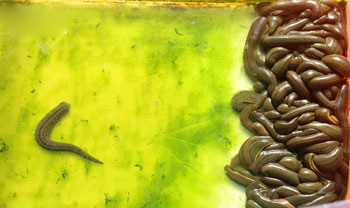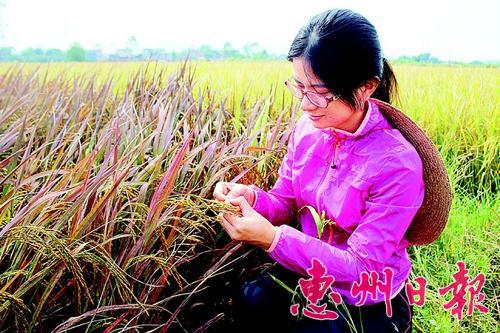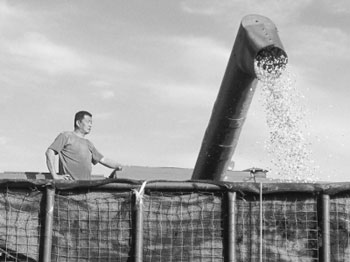Precious Medicinal Materials of "Blood-sucking insects" cultured in Baodi to treat Stroke

The quality of leeches raised by Gao Jianzhong is high.
Leeches are very demanding on the growing environment.
When it comes to leeches, everyone knows that they are terrible blood-sucking insects to avoid. In fact, leech scientific name leech, is a precious medicine, with the treatment of stroke, high blood pressure, clear blood stasis, amenorrhea, fall injury and other effects. A few days ago, the new media reporter of the North Network learned from Baodi District that the area relies on a good ecological environment to breed leeches on a large scale, turning blood-sucking insects into "beneficial insects", and has made unexpected achievements. Gao Jianzhong is one of the outstanding farmers, and the Tianjin Hongteng Aquatic Technology Development Co., Ltd., founded by him, has become the first scale leech breeding base in the country.
Realize large-scale farming
Up to now, there is still a folk prescription for the treatment of hypertension in Baodi, which is to grind dried leeches into powder and serve them with white water. Gao Jianzhong often hears from the villagers around him that this folk prescription has a wonderful effect, and many people still use it.
With the in-depth development of the medicinal value of leech, its huge market potential has attracted many farmers. At present, the annual demand gap for dried leeches in the domestic market is 300-500 tons (7-8 jin of fresh wet products produce 1 jin of dry products). Although the market prospect is good, artificial breeding is very difficult. It is understood that wild leeches have almost stringent requirements on the growth environment, so relying solely on catching wild leeches can not meet the market demand at all, and large-scale farming can solve the demand for this kind of "soft gold".
"leeches should lay eggs at the junction of water and soil, where there is plenty of water and moisture. When the temperature is between 25 ℃ and 28 ℃, the humidity, the tide, the softness of the soil, and the varieties of the surrounding plants all meet the conditions, the leeches will lay eggs. The normal growth period is half a year, hatching twice a year and producing a finished product. " When it comes to leech farming, Gao Jianzhong goes on and on.
Since 2012, Gao Jianzhong has tried to raise leeches on a small scale, ranging from dozens of mu to hundreds of mu. At present, the annual output of dry products is 40 to 50 tons, which is sold to pharmaceutical factories in Tianjin and Zhuhai and Anguo medicine market. However, compared with the huge gap, Gao Jianzhong's leech production is still relatively small. In order to achieve efficient aquaculture, Gao Jianzhong visited Sichuan, Northeast, and other places. At that time, the scale, standard, and technology of leech breeding in the country had not yet taken shape, but the market demand was urgent. Gao Jianzhong was introduced through the relevant departments. Find a Malaysian aquaculture expert, Professor Pan, and introduce leech breeding technology. "A leech breeding base of 3000 mu has been established this year. Under the guidance of Professor Pan, leech breeding and hatching have been done, and large-scale breeding has begun in the leech breeding area."
At present, Gao Jianzhong has formed a leading enterprise of agricultural industrialization with the integration of breeding, production, processing and sales through four modes: water tank (cage) culture, floor cage culture, three-dimensional culture of rice field and industrial cement pond breeding. it has become one of the 12 major urban agricultural projects in Baodi.
Science and technology support the development of urban agriculture
Feed is the key to large-scale cultivation of leeches. at present, there is no leech feed on the market. Gao Jianzhong's leeches mainly feed on field snails. The number of wild snails is uncontrollable, and using it as feed is tantamount to "relying on heaven for a living", and there is no guarantee at all. In order to realize large-scale breeding, Gao Jianzhong cooperated with Tianjin Agricultural College to set up a research group to develop leech feed to solve the problem of large-scale leech breeding.
Realizing large-scale breeding, Gao Jianzhong also thought about improving the efficiency of leech farming, considering the acceptability of farmers, he promoted the three-dimensional cultivation model of growing rice in paddy fields and raising leeches among the surrounding farmers. "this model has low input, high output and easy to popularize. The technical content of this model is not high, and the quality of leeches raised is also good. Farmers only need to simply lay out the rice fields, dig ditches, enter water, and drain water. " Gao Jianzhong said.
However, there is no guarantee for the yield of leeches cultivated in rice fields. In order to tackle key scientific and technological problems and increase the income of farmers around them, in 2013, Gao Jianzhong's Hongteng Aquatic Company, with the help of the Science and Technology Commission of Baodi District, set up the first academician workstation in the agricultural field of Baodi District, hired rice experts and Academician Chen Wenfu of the Chinese Academy of Engineering to solve the problem of three-dimensional planting, and introduced several new rice varieties suitable for leech growth. At present, 40 to 50 peasant households are trying three-dimensional interplanting of rice and leeches, increasing their income by more than 1000 yuan over the single planting of rice per mu.
Not only realized the increase of leech culture income, Gao Jianzhong's leech also created a brand. "some middlemen come to us to buy leeches. They report that although our leeches are more expensive than those in the south, they contain high levels of locustins and have a high rate of dry products from wet products. We are currently applying for the protection of geographical indications. " At present, the breeding area of pollution-free National Geographic indication species certified by the Ministry of Agriculture in Baodi District has reached 400000 mu, accounting for 1/3 of the 1.13 million mu of arable land in Baodi.
Research and development of deep processing products of leeches
After realizing the large-scale breeding of leeches, Gao Jianzhong not only considered to maintain and steadily improve the degree of scale, but also to achieve deep processing of leech products. "We are working with the Institute of traditional Chinese Medicine of the Chinese Academy of Sciences to increase the added value of leeches," he said. At present, the folk way of processing leeches is boiling in hot water, and it is processed with alum. If treated in this way, the medicinal component of the leech will be lost by 20% and 30%. Especially in summer days, leeches will deteriorate if they are not processed in time. In order to cultivate leeches for sustainable development, we plan to do primary processing after breeding. The leeches are freeze-dried by low-temperature dehydration, then powdered by nanotechnology and sold to pharmaceutical companies. Do some pre-treatment, leech ingredients will not be lost, at the same time, enterprises can also achieve high value-added products. "
In addition to continuous exploration in leech breeding and deep processing, Gao Jianzhong also plans to comprehensively sort out the leech breeding technology. "there is a great demand for leeches in the market, and we plan to release CD-ROMs to promote leech farming technology throughout the country," he said. It is expected to start making teaching materials on aquaculture techniques in April next year. "
Hao Fuhong, director of the agricultural committee of Baodi District, said in an interview with reporters that now Baodi District has set up four industrial belts: the southern waterfront ecological industrial belt (breeding in several townships with rich water resources); in the north, a superior vegetable industrial belt has been established (strengthening Shigezhuang radish, Niudaokou yam, Xin'an town cucumber, Fangzhuang edible fungus), vegetables can be sold to all parts of the country. Eastern characteristic industrial belt, green onions and garlic Tianying pepper storage and transportation, processing cold chain construction, fresh storage let farmers sell a good price; the west also has a 100000 mu of efficient facility agriculture. Relying on these four industrial belts, Baodi District has been working on the leading role of fine modern urban agriculture. And the small leeches expand the development of urban agriculture in another sky, so that the business of farmers, read out the big way.
Related
- A course of planting techniques and methods on how to grow carrots
- How to plant the latest tulips?
- Is it better to pick tea in the morning or in the afternoon? When is the best time for tea to be picked? what is the third or fifth tea?
- Launch Yuanxiao Happy combination Haocha + Tea Yuan healthy Taste
- Penghu Tourism "Fireworks 20 Parade with You"
- 2022 West Lake Happiness holds "Digital Revitalization Voucher" and draws iphone13 and laptop.
- Banqiao Fuzhou social houses are designed to change start-up combined with police elimination to create a safe and livable environment
- The convenient measure of "mechanical weeding" in Xinbei has been abused and the Agriculture Bureau has imposed heavy penalties on the illegal land consolidation.
- Changgeng University Joins Hands with Four Memory Factories to Rescue Memory Talent Shortage
- The list of Taiwan's top 100 MVP managers is listed by the Director-General of the Farmers' Association of Sanxia District.



